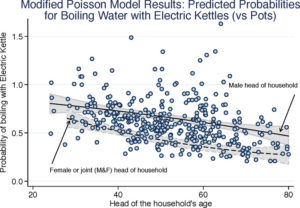Predictors of drinking water boiling & bottled water consumption in rural China: A hierarchical modeling approach
 Abstract/Summary: Approximately two billion people drink unsafe water. Boiling is the most commonly used household water treatment (HWT) method globally and in China. HWT can make water safer, but sustained adoption is rare and bottled water consumption is growing. To successfully promote HWT, an understanding of associated socioeconomic factors is critical. We collected survey data and water samples from 450 rural households in Guangxi Province, China. Covariates were grouped into blocks to hierarchically construct modified Poisson models and estimate risk ratios (RR) associated with boiling methods, bottled water, and untreated water. Female-headed households were most likely to boil (RR = 1.36, p < 0.01), and among boilers those using electric kettles rather than pots had higher income proxies (e.g., per capita TV ownership RR = 1.42, p < 0.01). Higher-income households with younger, literate, and male heads were more likely to purchase (frequently contaminated) bottled water, or use electric kettles if they boiled. Our findings show that boiling is not an undifferentiated practice, but one with different methods of varying effectiveness, environmental impact, and adoption across socioeconomic strata. Our results can inform programs to promote safer and more efficient boiling using electric kettles, and suggest that if rural China’s economy continues to grow then bottled water use will increase.
Abstract/Summary: Approximately two billion people drink unsafe water. Boiling is the most commonly used household water treatment (HWT) method globally and in China. HWT can make water safer, but sustained adoption is rare and bottled water consumption is growing. To successfully promote HWT, an understanding of associated socioeconomic factors is critical. We collected survey data and water samples from 450 rural households in Guangxi Province, China. Covariates were grouped into blocks to hierarchically construct modified Poisson models and estimate risk ratios (RR) associated with boiling methods, bottled water, and untreated water. Female-headed households were most likely to boil (RR = 1.36, p < 0.01), and among boilers those using electric kettles rather than pots had higher income proxies (e.g., per capita TV ownership RR = 1.42, p < 0.01). Higher-income households with younger, literate, and male heads were more likely to purchase (frequently contaminated) bottled water, or use electric kettles if they boiled. Our findings show that boiling is not an undifferentiated practice, but one with different methods of varying effectiveness, environmental impact, and adoption across socioeconomic strata. Our results can inform programs to promote safer and more efficient boiling using electric kettles, and suggest that if rural China’s economy continues to grow then bottled water use will increase.
Predictors of drinking water boiling & bottled water consumption in rural China: A hierarchical modeling approach
Authors: Cohen, A., Zhang, Q., Luo, Q., Tao, Y., Colford, J. M., & Ray, I.
Publication Year: 2017 | Journal / Publisher: Environmental Science & Technology
 Abstract/Summary: Approximately two billion people drink unsafe water. Boiling is the most commonly used household water treatment (HWT) method globally and in China. HWT can make water safer, but sustained adoption is rare and bottled water consumption is growing. To successfully promote HWT, an understanding of associated socioeconomic factors is critical. We collected survey data and water samples from 450 rural households in Guangxi Province, China. Covariates were grouped into blocks to hierarchically construct modified Poisson models and estimate risk ratios (RR) associated with boiling methods, bottled water, and untreated water. Female-headed households were most likely to boil (RR = 1.36, p < 0.01), and among boilers those using electric kettles rather than pots had higher income proxies (e.g., per capita TV ownership RR = 1.42, p < 0.01). Higher-income households with younger, literate, and male heads were more likely to purchase (frequently contaminated) bottled water, or use electric kettles if they boiled. Our findings show that boiling is not an undifferentiated practice, but one with different methods of varying effectiveness, environmental impact, and adoption across socioeconomic strata. Our results can inform programs to promote safer and more efficient boiling using electric kettles, and suggest that if rural China’s economy continues to grow then bottled water use will increase.
Abstract/Summary: Approximately two billion people drink unsafe water. Boiling is the most commonly used household water treatment (HWT) method globally and in China. HWT can make water safer, but sustained adoption is rare and bottled water consumption is growing. To successfully promote HWT, an understanding of associated socioeconomic factors is critical. We collected survey data and water samples from 450 rural households in Guangxi Province, China. Covariates were grouped into blocks to hierarchically construct modified Poisson models and estimate risk ratios (RR) associated with boiling methods, bottled water, and untreated water. Female-headed households were most likely to boil (RR = 1.36, p < 0.01), and among boilers those using electric kettles rather than pots had higher income proxies (e.g., per capita TV ownership RR = 1.42, p < 0.01). Higher-income households with younger, literate, and male heads were more likely to purchase (frequently contaminated) bottled water, or use electric kettles if they boiled. Our findings show that boiling is not an undifferentiated practice, but one with different methods of varying effectiveness, environmental impact, and adoption across socioeconomic strata. Our results can inform programs to promote safer and more efficient boiling using electric kettles, and suggest that if rural China’s economy continues to grow then bottled water use will increase.
PDF on Publisher Website | PDF on OSF
